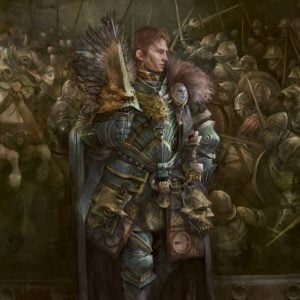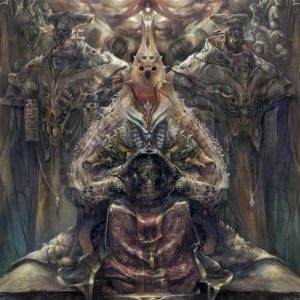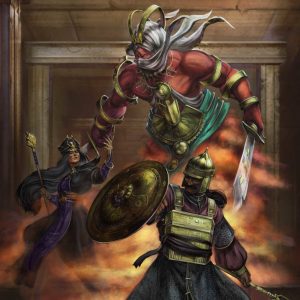Sieva, the Shield City of the Hundred Kingdoms, is one of the most visually striking and impressive cities in the world. It is built at the base of the massive escarpment that spans the distance from the towering volcanic majesty of Mt Flaegros all the way south to the Karpathos Mts that bound the Hundred Kingdoms to the south. Officially named the Petraepes, but now simply called the Drop and it forms a natural border between the Hundred Kingdoms and the Polmag Principalities.
If one approaches the city from the West, the first thing he will see will be the towering majesty of the Petraepes. As he approaches closer, he will discern the city and all of its towering glory. One of the most distinctive characteristics of Sieva is its unique architectural features: the first is the sheer height of the buildings. In most cities the buildings might rise to two or three floors at best. In Sieva most buildings are at least three stories high, often taller. This is partly explained due to the materials used in their construction: the dense, tough granite that was quarried from the Petraepes to carve a usable path through it.
But the truth is that Sieva was always intended to be a fortress city. As a result the tall buildings are arranged in concentric circles, placed flush against each other with no windows on the ground level and only modest ones in the levels above. Small bridged alleys provide access through each circle and are the only way one can cross from each circle to the other, forming the cities eponymous Wards. There are central gates that provide access to carts and wagons in the city, but each of these is offset from the other, facing a different cardinal direction.
All of this means that in the event of an attack, the invader would have to fight through each Ward, clearing it building by building all the while the defender is attacking him from fortified positions atop the towers that comprise the vast majority of the city.
All of these tall gray buildings with no easy door access and few winds would make for a very foreboding and unwelcoming city. Two idiosyncratic features breathe life and color into Sieva. The first is the city’s industry: cloth spinning and dyeing. Easy access to the Polmag wool markets in the east and the bountiful cotton fields of the northern plains by river provide ready access to the raw materials needed. The fast flowing river, the Danber, provides the power to countless mills while the miles of escarpment wall and rise and fall of the local topography provide a wealth of minerals and unique ecological niches for rare insect and vegetable dyes.
As a result, Sieva sports some of the most colorful clothing in the Hundred Kingdoms and the normally dour walls of the city are covered almost year round in brightly colored buntings as each noble house displays their wealth and influence while merchants advertise their wares while on the streets by tenting the small alleys, bringing even more color into even the smaller and darker corners of the city.
Given the defensive intent of every feature in the city, open spaces, even paved ones, few and far between. Coupled with narrow alleys and covered streets dedicated to business and commerce, there is little room for greenery or even leisure spots. As a result the residents discovered a unique use for the reinforced walls and tall towers they had: rooftop gardens. While only the wealthiest and largest towers in the city have actual grass and and on the rooftops, even the meanest tower will have a fenced and tiled roof with countless potted plants arranged around it. The beauty of ones rooftop garden has become a point of pride amongst the citizens of the city. Small walkways, either permanent stone arches or temporary wooden ones, create an ever shifting map of neighborhoods above the city, completely dedicated to leisure, relaxation and pleasure of every kind in stark contrast to the business dominated streets below.
While the original intent of the city’s rulers was that this rooftop pleasure realm be the exclusive realm of the nobility and the wealthier citizens, time and daring youth have conspired to largely eliminate this stuffy protocol. In a city where even the lowest street tough can afford quality fabrics, it is hard to keep social barriers, especially when the nobility is keen to break them down and ‘slum it’ in style. As a result, the rooftop gardens and plazas range all the way from royal gardens to gaily colored drinking stands surrounded by potted greenery and every possible combination in between.
While the upper and middle class can afford to do so, even as rich a city as Sieva cannot possibly be expected to house its entire population in stone towers. Most of the cities working population and labor class lives in the unofficial Ward of the Quarries. Carved directly into the escarpment itself to source stone for the city once the pass had been cleared, the quarries resemble nothing more than an ants nest shorn exposed by the hand of an uncaring god. Hot in the summer and cold in the winter, the Quarries are carved directly into the rock face of the escarpment, as steep walkways and narrow cliffside paths and ladders connect each level with the ones above and below. Despite the precipitous drop and cramped quarters, the Quarries are nonetheless filled to capacity and beyond as the lure of a job in the vats and dying centres of the city lures many from the countryside creating a vertiginous city above the city. There is a pronounced drop in quality and refinement of both housing and tenant the higher one rises in the Quarry. In fact it is rumored that the upper levels of the quarry connect directly to the lower levels of the Fortress’ dungeons and that one can pass from one hellish place to another if he knows the right people.
And that brings us to the Fortress, the largest military installation in the Hundred Kingdoms (although this is technically true only because the Sealed Temples is not part of the Hundred Kingdoms) Its sprawling mass stands atop the Petraepes, carefully guarding the Pass that was carved into the escarpment, making it both a promise of future trade concessions or the threat of rapid mobilization against the principalities, and it is the cornerstone around which Charles Armatellum brokered his deals with the Polmag Principalities that made them vassals to the Tellian Empire.
Even a general description of its ramparts, walls and secrets would require another entry. Suffice to say, for now, that its garrisons, multiple keeps and dungeon levels have gone largely unused since the fall of the last Emperor, as the sheer cost of maintaining and garrisoning such a fortress demands a heavy toll from an Empire and would beggar any but the greatest of kingdoms in this Age. The Office of the Chamberlain keeps the central keep manned at all times and regularly sends patrols into the further reaches of this massive structure. Almost all of them return.












